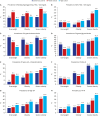Outbreak of Severe Obesity and Metabolic Complications in Children and Adolescents Using the Korea National School Health Examination (KNSHE) From 2017 to 2021
- PMID: 40696525
- PMCID: PMC12284304
- DOI: 10.3346/jkms.2025.40.e160
Outbreak of Severe Obesity and Metabolic Complications in Children and Adolescents Using the Korea National School Health Examination (KNSHE) From 2017 to 2021
Abstract
Background: This study aimed to estimate the prevalence of obesity in school children by severity and to assess the coronavirus disease 2019 (COVID-19) pandemic's impact on changes in the prevalence of obesity. In addition, the prevalence of obesity-related metabolic complications was calculated.
Methods: We used data from 390,580 school-aged children in the 2017-2021 Korea National School Health Examination to estimate the prevalence of obesity and assess secular trends in prevalence. We estimated the prevalence of metabolic complications in overweight and obese students with serological data and assessed their association with the degree of obesity, which was classified as overweight, obesity, and severe obesity per the criteria of the American Academy of Pediatrics.
Results: In 2021, the prevalence of overweight, obesity, and severe obesity among school children was 12.5%, 17.6%, and 4.9%, respectively, for boys and 10.8%, 11.9%, and 2.9%, respectively, for girls, and these values have been increasing significantly since 2017. Compared with the pre-COVID-19 period, the increase in the prevalence of obesity and severe obesity was remarkable, especially in elementary school students. The linear relationship between the prevalence of metabolic complications and the degree of obesity was evident in high school students. In elementary school students, similar relationships were found with nonalcoholic fatty liver disease and high blood pressure.
Conclusion: The severity of obesity in school-age children (especially younger children) is worsening, and this may predict an increase in the prevalence of related metabolic complications. To prevent long-term complications, it is essential to expand health screening programs.
Keywords: Metabolic Complications; Pediatric Obesity; Prevalence; Severe Obesity.
© 2025 The Korean Academy of Medical Sciences.
Conflict of interest statement
The authors have no potential conflicts of interest to disclose.
Figures




Similar articles
-
Trends and predictions to 2030 in demographic structures and metabolic health for children and adolescents in China: analysis of national school health surveys from 2000 to 2019.Lancet Child Adolesc Health. 2025 Aug;9(8):530-543. doi: 10.1016/S2352-4642(25)00140-3. Epub 2025 Jun 19. Lancet Child Adolesc Health. 2025. PMID: 40544851 Free PMC article.
-
Physical activity, diet and other behavioural interventions for improving cognition and school achievement in children and adolescents with obesity or overweight.Cochrane Database Syst Rev. 2018 Mar 2;3(3):CD009728. doi: 10.1002/14651858.CD009728.pub4. Cochrane Database Syst Rev. 2018. PMID: 29499084 Free PMC article.
-
Physical activity, diet and other behavioural interventions for improving cognition and school achievement in children and adolescents with obesity or overweight.Cochrane Database Syst Rev. 2018 Jan 29;1(1):CD009728. doi: 10.1002/14651858.CD009728.pub3. Cochrane Database Syst Rev. 2018. Update in: Cochrane Database Syst Rev. 2018 Mar 02;3:CD009728. doi: 10.1002/14651858.CD009728.pub4. PMID: 29376563 Free PMC article. Updated.
-
Prevalence of Extremely Severe Obesity and Metabolic Dysfunction Among US Children and Adolescents.JAMA Netw Open. 2025 Jul 1;8(7):e2521170. doi: 10.1001/jamanetworkopen.2025.21170. JAMA Netw Open. 2025. PMID: 40668581 Free PMC article.
-
Measures implemented in the school setting to contain the COVID-19 pandemic.Cochrane Database Syst Rev. 2022 Jan 17;1(1):CD015029. doi: 10.1002/14651858.CD015029. Cochrane Database Syst Rev. 2022. Update in: Cochrane Database Syst Rev. 2024 May 2;5:CD015029. doi: 10.1002/14651858.CD015029.pub2. PMID: 35037252 Free PMC article. Updated.
References
-
- Anderson LN, Yoshida-Montezuma Y, Dewart N, Jalil E, Khattar J, De Rubeis V, et al. Obesity and weight change during the COVID-19 pandemic in children and adults: a systematic review and meta-analysis. Obes Rev. 2023;24(5):e13550. - PubMed
MeSH terms
LinkOut - more resources
Full Text Sources
Medical

